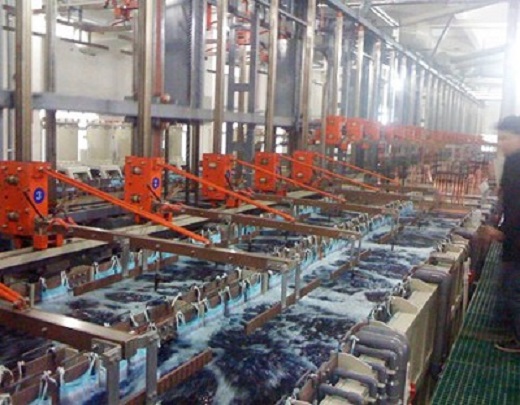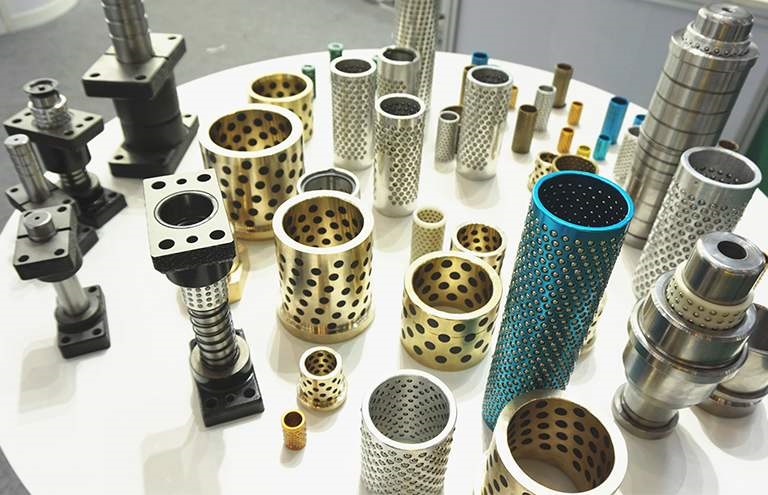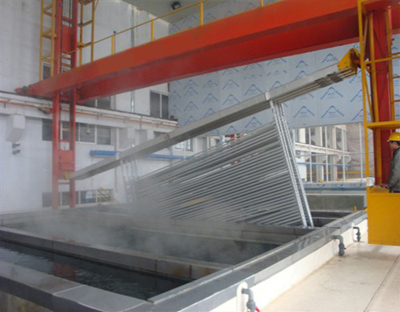1 . Preview:
Recently, the commonly used processes for galvanizing in China include basic zincate galvanizing, chloride acid galvanizing and sulfate galvanizing. Alkaline zincate zinc plating process has the advantages of simple bath composition, fine crystallization, easy passivation of coating, no discoloration of color passivation film and simple treatment of electroplating wastewater. The automatic alkaline zincate galvanizing production line used by the author’s company can automatically complete the whole process of electroplating, pre-treatment and post-treatment of electroplating through mechanical devices. It has many advantages, such as high production efficiency, low labor intensity, small floor area, few operators, convenient process maintenance, stable product quality and so on, and improves the operating conditions. However, there are many influencing factors involved in mass production of the production line. If you do not pay attention to daily maintenance, there will be quality problems. This paper describes the daily maintenance methods and precautions of bath solution from each link of galvanizing production line, in order to enable technicians and operators to reasonably maintain the production line, so as to ensure the continuity of production.
2. Daily maintenance of bath solution for automatic galvanizing production line:
1, process flow basic zincate zinc plating process includes three parts: pre plating treatment, zinc plating and post plating treatment. The specific process is: hanging → electrolytic degreasing → hot water washing → water washing → hydrochloric acid activation → water washing → neutralization → water washing → galvanizing → water washing → light out → water washing → Color Passivation → water washing → hot water washing → drying → hanging down.
2, bath solution maintenance basic zincate bath solution maintenance mainly involves the control of zinc content, sodium hydroxide content (hereinafter referred to as “alkali content”), additives and bath impurities.
① Control of zinc content when the zinc content is controlled at 8 ~ 12g / L, it can meet the needs of production. In practice, due to the wide variety of galvanized products and the separation of each plating bath, the plating amount of each bath is different. This difference is easy to cause the zinc content of individual plating bath to be high or low. Therefore, the operator should control the zinc content of the plating bath by changing the hanging amount of the zinc plate of each plating bath according to the test results of the bath solution. Technicians conduct daily process guidance and supervision. The zinc plate is suspended by a special stainless steel basket wrapped with an anode bag, and the stainless steel plate is used as an insoluble anode. Taking the 4500l plating bath as an example, only one zinc plate needs to be hung in daily production, and then 8 ~ 9 stainless steel plates can meet the requirements of zinc supplement and conductivity.
② The content of sodium hydroxide is controlled in the plating solution containing dpe-1ii additive, and the content of sodium hydroxide is generally controlled at 100 ~ 130g / L “。 In winter, the low temperature leads to the decrease of the conductivity of the bath, so the alkali content can be appropriately increased to strengthen the dispersion and coverage of the bath. However, the highest content of sodium hydroxide should not exceed 160g / L, otherwise it will increase the consumption of brightener and accelerate the dissolution of zinc anode plate, which is not conducive to the maintenance of bath liquid. In addition, the alkali content in the plating solution will be gradually reduced due to the hanging insoluble steel plate, the volatilization of bath solution and the removal of workpiece. Therefore, it should be supplemented in time according to the test results.
③ Control of additives dpe-ii and wbz-1ii are mainly used as main additives and brighteners for basic zincate galvanizing. The manufacturers of these two additives provide cylinder opening quantity and production maintenance quantity, which can be added as required. The addition method is based on the principle of “less work and more work”. The operators of the production line shall maintain the additives according to the production situation before working every day. The electroplating production line is equipped with equipment for monitoring and recording the electroplating time and current of the plating tank. The technicians can calculate the addition amount according to the consumption per kiloampere hour every week and adjust it in combination with the addition amount of the operators.
④ Control of impurities in the plating bath the impurities in the galvanizing bath mainly include inorganic and organic: inorganic impurities are common, such as copper, iron and lead, while organic impurities are mainly the decomposition products of additives in the plating bath and impurities such as oil pollution brought by unclean pretreatment. (1) There are many ways to remove metal impurities. Sodium sulfide treatment is not used because the addition amount is not easy to control and the actual effect is not obvious. Zinc powder or alkaline zinc plating impurity remover can be used to remove impurities in alkaline zincate zinc plating bath solution. For example, gray coating and local coating blackening have occurred in the inner hole groove (low current density area) of plated parts (guide sleeve, piston, etc.) in the production process. It is confirmed by Hull groove test that it is caused by metal impurity pollution. 778 alkaline zinc plating solution impurity remover is used to solve this problem. The treatment method can be operated according to the product instructions. What needs to be added is that if the problem can be solved by zinc powder impurity removal through Hall cell test, zinc powder impurity removal should be used as far as possible, because although 778 alkaline zinc plating impurity removal agent can effectively remove a variety of metal impurities, it has a certain impact on additives, and an appropriate amount of additives should be added to the treated tank solution. (2) When there are too many organic impurities in the bath liquid, the coating will be foggy and flowery, which will lead to brittle coating in serious cases. If too many additives have little effect, activated carbon treatment can only be carried out according to the situation. The activated carbon particles shall be evenly distributed into the tank liquid according to the calculated amount of 4 ~ 5g / L, and the tank liquid shall be fully stirred (air stirred) for 4h, and then stand for more than 6h. After standing, the tank liquid is filtered through an alkaline filter, and finally the additive can be adjusted according to the hull tank test for production. For the galvanizing production line, it is best to conduct activated carbon treatment on the tank liquid every half a year. Each tank liquid can be treated one by one at an interval of 3 ~ 5D to ensure the continuity of production. No matter what kind of impurity is treated, it will inevitably have a certain impact on production and increase drug consumption. Therefore, prevention must be the main maintenance of production line slot solution. (1) It is best to use secondary pure water for preparing and replenishing tank liquid, and the workshop is best equipped with secondary pure water preparation system. (2) Pay full attention to the purchase quality of drugs. The purchased zinc plate shall be subject to strict composition inspection, and the unqualified zinc plate shall not be used. If conditions permit, use No. 0 zinc ingot (i.e. zn99.995) as far as possible. (3) Strengthen the daily cleaning of various conductive parts to prevent the pollution of copper and rust to the tank liquid. (4) In addition to using high-quality zinc plates and drugs, the non-conductive area of the hanger should also be protected. At the same time, attention should be paid to standardized production operation and pretreatment process. The workpiece falling into the tank liquid must be taken out as soon as possible.
⑤ Temperature control according to the influence of indoor temperature, test the tank liquid at the best time of each season, and record the content of various components, so as to be the best tank liquid parameter suitable for the workshop. According to the changes of these parameters and reference temperature, the bath can be adjusted in advance to make it in the best running state and ensure the product quality. The workshop of the author’s company is located in the north, and the indoor temperature is low in winter, so the corrosion-resistant heating equipment (such as titanium heating pipe) combined with temperature control equipment can keep the tank liquid temperature above 16 ° C, so that it can be used normally in winter without adjusting according to the season.
3,maintenance of bath solution before and after plating:
① pretreatment pretreatment processes mainly include electrolytic degreasing, pickling, neutralization, etc. Its function is mainly to remove the oil stain, oxide layer and rust on the plated parts.
(1) There are two ways of electrolytic oil removal: cathode oil removal and anode oil removal. If conditions permit, the combination of anode and cathode can be used for oil removal. When anode degreasing is adopted, the time shall not be too long, otherwise it will cause certain corrosion to the workpiece. After degreasing a batch of parts, it was found that there were many snowflake like corrosion spots on the surface of parts. The reason is that it was in summer and the temperature and humidity were high, so slight corrosion had occurred on the part surface before degreasing, and anodic degreasing aggravated the corrosion degree of the part surface. After changing to cathode degreasing, this phenomenon disappears immediately. The electrolytic degreasing tank is best equipped with overflow device to facilitate the discharge of oil stains. If there is no overflow port, the oil stain shall be removed regularly to prevent the oil stain from being carried out by the raised workpiece, thus affecting other tank fluids. Some operators sometimes degrease the unqualified plated parts and the plated parts to be plated together. Although the coating can be removed, it will pollute the bath solution and aggravate the corrosion of the workpiece surface when anode degreasing is used.
(2) The main function of pickling is to remove the oxide layer on the workpiece surface, expose the metal surface and prepare for galvanizing. It is not recommended to use the pickling bath solution as stripping solution, otherwise chromium ions will be brought into the pickling solution, which will affect the subsequent bath solution. Hydrochloric acid deplating tank and water washing tank with exhaust device are set near the hanging position of the production line, which can not only facilitate the deplating of unqualified products, but also avoid the pollution of hydrochloric acid to qualified products. During the pretreatment, the oil and rust must be removed according to the process regulations, and the surface state of the workpiece must be observed. The tank liquid such as degreasing, pickling and neutralization shall be tested, analyzed and fed regularly, and the tank liquid shall be filtered according to the actual use. The acid tank shall be regularly discharged from the cylinder foot and updated.
② Post treatment post plating treatment mainly includes three parts: light emitting, color blunting and drying. High chromium passivation was used in the initial stage of production. High chromium passivation is to form a film in the air. When passivating pin shaft parts, after the workpiece is raised, due to the uneven distribution of passivation solution on the workpiece surface, the color of the workpiece is uneven, and even the upper end face cannot be blunt and the substrate will be exposed. Then the low chromium passivation process was used to solve this problem. Therefore, low chromium passivation process is recommended for all production lines. For low chromium passivation, there are many formulas on the market. Special color passivation powder or prepared passivation concentrate can be used. Routine maintenance can be carried out according to the instructions. It should be emphasized that due to the large output of the electroplating production line, it is best to choose the passivation solution formula with convenient maintenance and wide application range, especially the pH application range of the passivation solution should be as wide as possible. The acetic acid low chromium passivation process prepared by the workshop has been used in the rolling galvanizing production line. It is necessary to prepare concentrated solution according to the production situation to maintain the tank solution. However, compared with the mature Color Passivation products in the market, the maintenance frequency and requirements for operators are high. When the output is large, it needs to be maintained almost every day. Later, it is gradually changed back to the passivation process of hanging plating line. No matter which process is adopted, it shall be determined according to the actual production situation and cost requirements of the workshop.
③ After each treatment process, there are several water washing processes, which are used to clean the liquid left on the workpiece in the previous process and prepare for the next process. During the operation of the production line, the composition of the washing tank will increase with the extension of service time, and the direction of the composition of the tank liquid in the previous process will be close. Improper maintenance of water washing tank liquid will pollute the subsequent tank liquid and workpiece. Measures such as continuous water replenishment, overflow and air mixing shall be taken to maintain the water washing tank liquid, which shall not only ensure that the water washing tank liquid is within the normal use range, but also take into account the pressure of wastewater treatment, so as to reasonably allocate resources.
3.Process management and control of electroplating production line:
The maintenance and management of plating bath is inseparable from the process management of production line. Reasonable process management is a necessary condition to ensure product quality. In the process of automatic and continuous production, the strict implementation of process specifications is the guarantee of product quality. Therefore, the process specification should not only guide the production, but also ensure the effectiveness and operability of the production site. There shall be clear regulations on the loading capacity of workpieces in each slot, type of hanging tools, electroplating current density, electroplating time and other key production factors. During production, the operation specifications shall be strictly observed, and the process shall not be added or reduced arbitrarily or the process sequence shall not be changed. At the same time, the main parameters in the production process are recorded in detail, which can not only ensure the smooth implementation of the process, but also accurately trace the problem tank liquid and solve it in time in case of product quality problems. The implementation of the process shall be checked regularly and irregularly, and the problems found shall be handled in time. In addition, we should strengthen the implementation of cleaner production and pay attention to regular teaching and training for employees. Special personnel shall be designated to add drugs, technicians and production lines shall have complete drug addition records, and perfect tank liquid files shall be established. The quality of various drugs used in the production line shall be strictly controlled. For key drugs such as sodium hydroxide, additives and passivation drugs, a specific manufacturer shall be designated. Even if the pharmaceutical composition is the same, try not to change the manufacturer at will. Ensure that each batch of drugs are inspected, and Hull cell test shall be conducted for each batch of additives to verify their actual effect and ensure that the dosage of additives is true and effective. Strictly control the test discipline, establish the test standard and ensure the test quality. To ensure the quality of drugs, water and glassware, and regularly maintain, repair and calibrate the laboratory equipment. Through the training of laboratory technicians and combined with daily assessment, the laboratory ability of laboratory technicians is improved.
4.Conclusion:
The maintenance and management of plating bath involves many aspects. Technicians and operators should master correct maintenance skills and methods according to their own nature of work, and constantly summarize experience in daily production management. In case of problems, we should discuss together and summarize a set of maintenance and management methods suitable for the production line of the workshop. Only by monitoring the production raw materials, strictly implementing the process discipline and using scientific and reasonable analysis and maintenance methods can we give full play to the advantages of continuous production of automatic production line and ensure its efficient operation.








 Jul. 17, 2020
Jul. 17, 2020 



